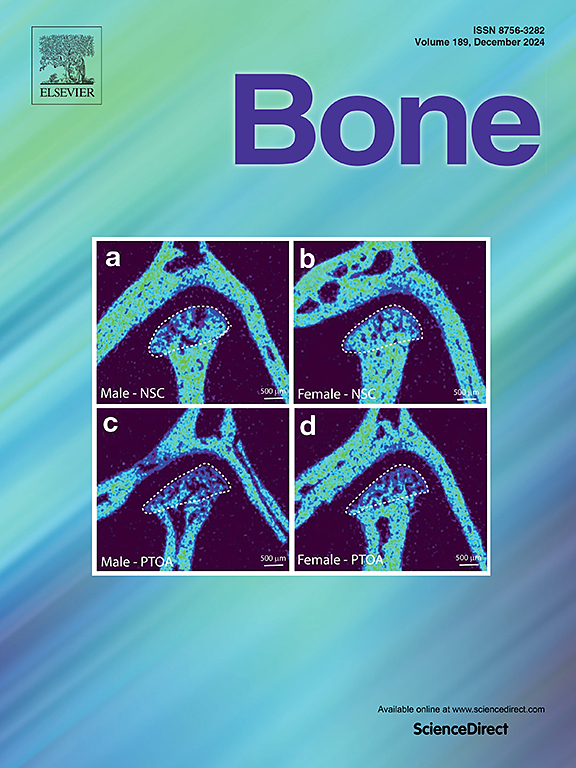The effects of endurance trainability phenotype, sex, and interval running training on bone collagen synthesis in adult rats
IF 3.5
2区 医学
Q2 ENDOCRINOLOGY & METABOLISM
引用次数: 0
Abstract
Bone is influenced by many factors such as genetics and mechanical loading, but the short-term physiological effects of these factors on bone (re)modelling are not well characterised. This study investigated the effects of endurance trainability phenotype, sex, and interval running training (7-week intervention) on bone collagen formation in rats using a deuterium oxide stable isotope tracer method. Bone samples of the femur diaphysis, proximal tibia, mid-shaft tibia, and distal tibia were collected after necropsy from forty-six 9 ± 3-month male and female rats selectively bred for yielding low (LRT) or high (HRT) responses to endurance training. Bone collagen proteins were isolated and hydrolysed, and fractional synthetic rates (FSRs) were determined by the incorporation of deuterium into protein-bound alanine via GC-pyrolysis-IRMS. There was a significant large main effect of phenotype at the femur site (p < 0.001; η2g = 0.473) with HRT rats showing greater bone collagen FSRs than LRT rats. There was a significant large main effect of phenotype (p = 0.008; η2g = 0.178) and a significant large main effect of sex (p = 0.005; η2g = 0.196) at the proximal site of the tibia with HRT rats showing greater bone collagen FSRs than LRT rats, and male rats showing greater bone collagen FSRs compared to female rats. There was a significant large main effect of training at the mid-shaft site of the tibia (p = 0.012; η2g = 0.159), with rats that underwent interval running training having greater bone collagen FSRs than control rats. Similarly, there was a significant large main effect of training at the distal site of the tibia (p = 0.050; η2g = 0.156), with rats in the interval running training group having greater bone collagen FSRs compared to rats in the control group. Collectively, this evidence highlights that bone responses to physiological effects are site-specific, indicating that interval running training has positive effects on bone collagen synthesis at the tibial mid-shaft and distal sites, whilst genetic factors affect bone collagen synthesis at the femur diaphysis (phenotype) and proximal tibia (phenotype and sex) in rats.
耐力训练表型、性别和间歇性跑步训练对成年大鼠骨胶原合成的影响。
骨骼受遗传和机械负荷等多种因素的影响,但这些因素对骨骼(再)建模的短期生理影响尚未得到很好的描述。本研究采用氧化氘稳定同位素示踪法研究了耐力训练表型、性别和间歇性跑步训练(7 周干预)对大鼠骨胶原形成的影响。在对 46 只 9 ± 3 个月大的雄性和雌性大鼠进行尸检后收集了股骨干骺端、胫骨近端、胫骨中轴和胫骨远端的骨骼样本,这些大鼠经过选择性饲养,对耐力训练的反应较低(LRT)或较高(HRT)。分离并水解骨胶原蛋白,通过气相色谱-热解-质谱仪(GC-pyrolysis-IRMS)将氘掺入蛋白结合的丙氨酸中,测定分数合成率(FSR)。在股骨部位,HRT 大鼠比 LRT 大鼠显示出更大的骨胶原 FSR,表型的主效应非常明显(p 2g = 0.473)。表型(p = 0.008;η2g = 0.178)和性别(p = 0.005;η2g = 0.196)对胫骨近端部位有显著的大主效应,HRT 大鼠比 LRT 大鼠显示出更大的骨胶原 FSR,雄性大鼠比雌性大鼠显示出更大的骨胶原 FSR。在胫骨中轴部位,训练具有显著的大型主效应(p = 0.012;η2g = 0.159),接受间歇跑步训练的大鼠比对照组大鼠的骨胶原 FSR 更大。同样,胫骨远端部位的训练也存在显著的大主效应(p = 0.050;η2g = 0.156),与对照组大鼠相比,间歇跑训练组大鼠的骨胶原 FSR 更大。总之,这些证据突出表明,骨骼对生理效应的反应是有部位特异性的,表明间歇跑训练对胫骨中轴和远端部位的骨胶原合成有积极影响,而遗传因素则影响大鼠股骨干骺端(表型)和胫骨近端(表型和性别)的骨胶原合成。
本文章由计算机程序翻译,如有差异,请以英文原文为准。
求助全文
约1分钟内获得全文
求助全文
来源期刊

Bone
医学-内分泌学与代谢
CiteScore
8.90
自引率
4.90%
发文量
264
审稿时长
30 days
期刊介绍:
BONE is an interdisciplinary forum for the rapid publication of original articles and reviews on basic, translational, and clinical aspects of bone and mineral metabolism. The Journal also encourages submissions related to interactions of bone with other organ systems, including cartilage, endocrine, muscle, fat, neural, vascular, gastrointestinal, hematopoietic, and immune systems. Particular attention is placed on the application of experimental studies to clinical practice.
 求助内容:
求助内容: 应助结果提醒方式:
应助结果提醒方式:


